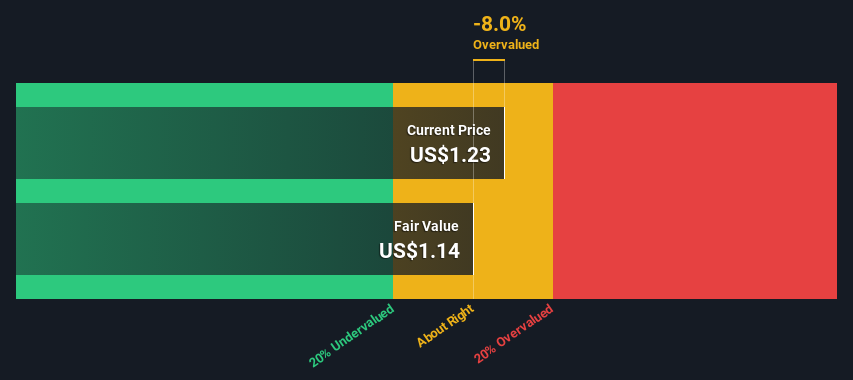- United States
- /
- Personal Products
- /
- NasdaqGM:DSY
Estimating The Intrinsic Value Of Big Tree Cloud Holdings Limited (NASDAQ:DSY)

Key Insights
- The projected fair value for Big Tree Cloud Holdings is US$1.14 based on 2 Stage Free Cash Flow to Equity
- With US$1.23 share price, Big Tree Cloud Holdings appears to be trading close to its estimated fair value
- Big Tree Cloud Holdings' peers seem to be trading at a higher premium to fair value based onthe industry average of -231%
In this article we are going to estimate the intrinsic value of Big Tree Cloud Holdings Limited (NASDAQ:DSY) by taking the forecast future cash flows of the company and discounting them back to today's value. Our analysis will employ the Discounted Cash Flow (DCF) model. There's really not all that much to it, even though it might appear quite complex.
We generally believe that a company's value is the present value of all of the cash it will generate in the future. However, a DCF is just one valuation metric among many, and it is not without flaws. If you want to learn more about discounted cash flow, the rationale behind this calculation can be read in detail in the Simply Wall St analysis model.
See our latest analysis for Big Tree Cloud Holdings
The Model
We use what is known as a 2-stage model, which simply means we have two different periods of growth rates for the company's cash flows. Generally the first stage is higher growth, and the second stage is a lower growth phase. To begin with, we have to get estimates of the next ten years of cash flows. Seeing as no analyst estimates of free cash flow are available to us, we have extrapolate the previous free cash flow (FCF) from the company's last reported value. We assume companies with shrinking free cash flow will slow their rate of shrinkage, and that companies with growing free cash flow will see their growth rate slow, over this period. We do this to reflect that growth tends to slow more in the early years than it does in later years.
Generally we assume that a dollar today is more valuable than a dollar in the future, and so the sum of these future cash flows is then discounted to today's value:
10-year free cash flow (FCF) forecast
| 2025 | 2026 | 2027 | 2028 | 2029 | 2030 | 2031 | 2032 | 2033 | 2034 | |
| Levered FCF ($, Millions) | US$3.70m | US$3.79m | US$3.89m | US$3.99m | US$4.08m | US$4.18m | US$4.28m | US$4.39m | US$4.49m | US$4.60m |
| Growth Rate Estimate Source | Est @ 2.67% | Est @ 2.58% | Est @ 2.52% | Est @ 2.48% | Est @ 2.45% | Est @ 2.43% | Est @ 2.41% | Est @ 2.40% | Est @ 2.40% | Est @ 2.39% |
| Present Value ($, Millions) Discounted @ 8.1% | US$3.4 | US$3.2 | US$3.1 | US$2.9 | US$2.8 | US$2.6 | US$2.5 | US$2.4 | US$2.2 | US$2.1 |
("Est" = FCF growth rate estimated by Simply Wall St)
Present Value of 10-year Cash Flow (PVCF) = US$27m
After calculating the present value of future cash flows in the initial 10-year period, we need to calculate the Terminal Value, which accounts for all future cash flows beyond the first stage. The Gordon Growth formula is used to calculate Terminal Value at a future annual growth rate equal to the 5-year average of the 10-year government bond yield of 2.4%. We discount the terminal cash flows to today's value at a cost of equity of 8.1%.
Terminal Value (TV)= FCF2034 × (1 + g) ÷ (r – g) = US$4.6m× (1 + 2.4%) ÷ (8.1%– 2.4%) = US$82m
Present Value of Terminal Value (PVTV)= TV / (1 + r)10= US$82m÷ ( 1 + 8.1%)10= US$38m
The total value is the sum of cash flows for the next ten years plus the discounted terminal value, which results in the Total Equity Value, which in this case is US$65m. The last step is to then divide the equity value by the number of shares outstanding. Compared to the current share price of US$1.2, the company appears around fair value at the time of writing. The assumptions in any calculation have a big impact on the valuation, so it is better to view this as a rough estimate, not precise down to the last cent.

The Assumptions
Now the most important inputs to a discounted cash flow are the discount rate, and of course, the actual cash flows. If you don't agree with these result, have a go at the calculation yourself and play with the assumptions. The DCF also does not consider the possible cyclicality of an industry, or a company's future capital requirements, so it does not give a full picture of a company's potential performance. Given that we are looking at Big Tree Cloud Holdings as potential shareholders, the cost of equity is used as the discount rate, rather than the cost of capital (or weighted average cost of capital, WACC) which accounts for debt. In this calculation we've used 8.1%, which is based on a levered beta of 1.016. Beta is a measure of a stock's volatility, compared to the market as a whole. We get our beta from the industry average beta of globally comparable companies, with an imposed limit between 0.8 and 2.0, which is a reasonable range for a stable business.
SWOT Analysis for Big Tree Cloud Holdings
- Debt is well covered by earnings and cashflows.
- Current share price is above our estimate of fair value.
- Shareholders have been diluted in the past year.
- DSY's financial characteristics indicate limited near-term opportunities for shareholders.
- Lack of analyst coverage makes it difficult to determine DSY's earnings prospects.
- Total liabilities exceed total assets, which raises the risk of financial distress.
Next Steps:
Although the valuation of a company is important, it shouldn't be the only metric you look at when researching a company. The DCF model is not a perfect stock valuation tool. Preferably you'd apply different cases and assumptions and see how they would impact the company's valuation. For instance, if the terminal value growth rate is adjusted slightly, it can dramatically alter the overall result. For Big Tree Cloud Holdings, we've put together three relevant aspects you should assess:
- Risks: Every company has them, and we've spotted 6 warning signs for Big Tree Cloud Holdings (of which 3 are a bit concerning!) you should know about.
- Other High Quality Alternatives: Do you like a good all-rounder? Explore our interactive list of high quality stocks to get an idea of what else is out there you may be missing!
- Other Environmentally-Friendly Companies: Concerned about the environment and think consumers will buy eco-friendly products more and more? Browse through our interactive list of companies that are thinking about a greener future to discover some stocks you may not have thought of!
PS. Simply Wall St updates its DCF calculation for every American stock every day, so if you want to find the intrinsic value of any other stock just search here.
Valuation is complex, but we're here to simplify it.
Discover if Big Tree Cloud Holdings might be undervalued or overvalued with our detailed analysis, featuring fair value estimates, potential risks, dividends, insider trades, and its financial condition.
Access Free AnalysisHave feedback on this article? Concerned about the content? Get in touch with us directly. Alternatively, email editorial-team (at) simplywallst.com.
This article by Simply Wall St is general in nature. We provide commentary based on historical data and analyst forecasts only using an unbiased methodology and our articles are not intended to be financial advice. It does not constitute a recommendation to buy or sell any stock, and does not take account of your objectives, or your financial situation. We aim to bring you long-term focused analysis driven by fundamental data. Note that our analysis may not factor in the latest price-sensitive company announcements or qualitative material. Simply Wall St has no position in any stocks mentioned.
Have feedback on this article? Concerned about the content? Get in touch with us directly. Alternatively, email editorial-team@simplywallst.com
About NasdaqGM:DSY
Big Tree Cloud Holdings
Manufactures and sells personal care products and other consumer goods.
Slight with acceptable track record.
Market Insights
Community Narratives




